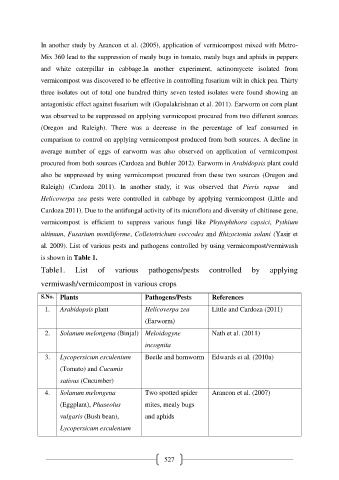Page 537 - e-Book
P. 537
In another study by Arancon et al. (2005), application of vermicompost mixed with Metro-
Mix 360 lead to the suppression of mealy bugs in tomato, mealy bugs and aphids in peppers
and white caterpillar in cabbage.In another experiment, actinomycete isolated from
vermicompost was discovered to be effective in controlling fusarium wilt in chick pea. Thirty
three isolates out of total one hundred thirty seven tested isolates were found showing an
antagonistic effect against fusarium wilt (Gopalakrishnan et al. 2011). Earworm on corn plant
was observed to be suppressed on applying vermicopost procured from two different sources
(Oregon and Raleigh). There was a decrease in the percentage of leaf consumed in
comparison to control on applying vermicompost produced from both sources. A decline in
average number of eggs of earworm was also observed on application of vermicompost
procured from both sources (Cardoza and Buhler 2012). Earworm in Arabidopsis plant could
also be suppressed by using vermicompost procured from these two sources (Oregon and
Raleigh) (Cardoza 2011). In another study, it was observed that Pieris rapae and
Helicoverpa zea pests were controlled in cabbage by applying vermicompost (Little and
Cardoza 2011). Due to the antifungal activity of its microflora and diversity of chitinase gene,
vermicompost is efficient to suppress various fungi like Phytophthora capsici, Pythium
ultimum, Fusarium moniliforme, Colletotrichum coccodes and Rhizoctonia solani (Yasir et
al. 2009). List of various pests and pathogens controlled by using vermicompost/vermiwash
is shown in Table 1.
Table1. List of various pathogens/pests controlled by applying
vermiwash/vermicompost in various crops
S.No. Plants Pathogens/Pests References
1. Arabidopsis plant Helicoverpa zea Little and Cardoza (2011)
(Earworm)
2. Solanum melongena (Binjal) Meloidogyne Nath et al. (2011)
incognita
3. Lycopersicum esculentum Beetle and hornworm Edwards et al. (2010a)
(Tomato) and Cucumis
sativus (Cucumber)
4. Solanum melongena Two spotted spider Arancon et al. (2007)
(Eggplant), Phaseolus mites, mealy bugs
vulgaris (Bush bean), and aphids
Lycopersicum esculentum
527

